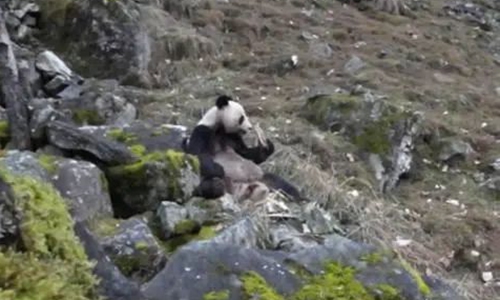Chinese lawmaker suggests monitoring system and market mechanism to protect wildlife in Qinling, Shaanxi

The world's only brown panda bred in captivity, named "Qizai," belongs to an extremely rare subspecies found in the Qinling Mountains, Northwest China's Shaanxi Province. Photo: Xinhua
A Chinese lawmaker suggested to establish a monitoring and early warning system for rare wild animals and plants in Qinling Mountains, Northwest China's Shaanxi Province and to introduce market mechanism for the protection of some wild plants with development prospects during the ongoing two sessions.
Zan Linsen, a deputy to the National People's Congress (NPC) and deputy director of the Shaanxi Forestry Bureau, said the system is crucial since wildlife protection in Qinling concerns the overall situation of biodiversity conservation in China, noting that wildlife plays an important part of the natural ecosystem and serves as indispensable strategic resources to ensure the sustainable development of the economy and society.
Zan suggested regular assessments on the living environment of wild flora and fauna and that their population status should be conducted through a system of field surveys, monitoring and evaluation and protection measures should be adjusted and optimized accordingly.
Qinling is a priority area for biodiversity conservation in China and one of the key areas of global biodiversity, said the lawmaker. The area is home to 3,883 species of spermatophyte and 587 species of terrestrial vertebrate, among which 22 species of wildlife plants and 119 species of animals are on the national list of key protection.
Tremendous efforts have been made by Shaanxi in protecting rare animals including giant panda, crested ibis and golden monkey and wild plants such as Taxus chinensis and dove trees, which have saved these species from endangered status through the protection and restoration of their habitats, rescuing injured animals, artificial breeding and construction of gene banks.
According to Zan, the population of wild giant pandas in Shaanxi increased from 109 in the 1980s to today's 345 and the number of pandas in captivity through artificial breeding reached 37. Meanwhile, the number of crested ibises has surpassed 7,000 from seven when they were first discovered. The distribution of wild animals and plants in the province has gradually expanded.
However, the protection work still faces various difficulties and problems due to many factors and changes in the populations of treasured animals and plants.
For example, the number of pandas and the changes in their population are disclosed once every 10 years based on nationwide surveys. The latest release of the statistics was back in 2014, Diao Kunpeng, a panda expert and director of Beijing Qingye Ecology, told the Global Times on Thursday.
Thus, Zan suggested to establish a monitoring and early warning system to protect the integrity of Qinling's ecosystem by building ecological corridors and restoring lost and degraded habitats.
Besides, Zan suggested to strengthen scientific research on constructing resource banks of germline cells and stem cells for unique species of Qinling Mountains, and to conduct research on the collection of plant species, gene conservation, and habitat introduction for plant species.
Moreover, Zan suggested the introduction of a market mechanism in the protection of rare species of wild plants, proactively exploring new models for the conservation of some wild plants that have market demand and real development prospects.
For example, social capitals are welcome to participate in the construction of breeding bases and to conduct cultivation and promotion. On the basis of meeting the demand of habitat introduction and expanding distribution of the wild population, the bred wild plants can solve the market supply and realize sustainable utilization.



